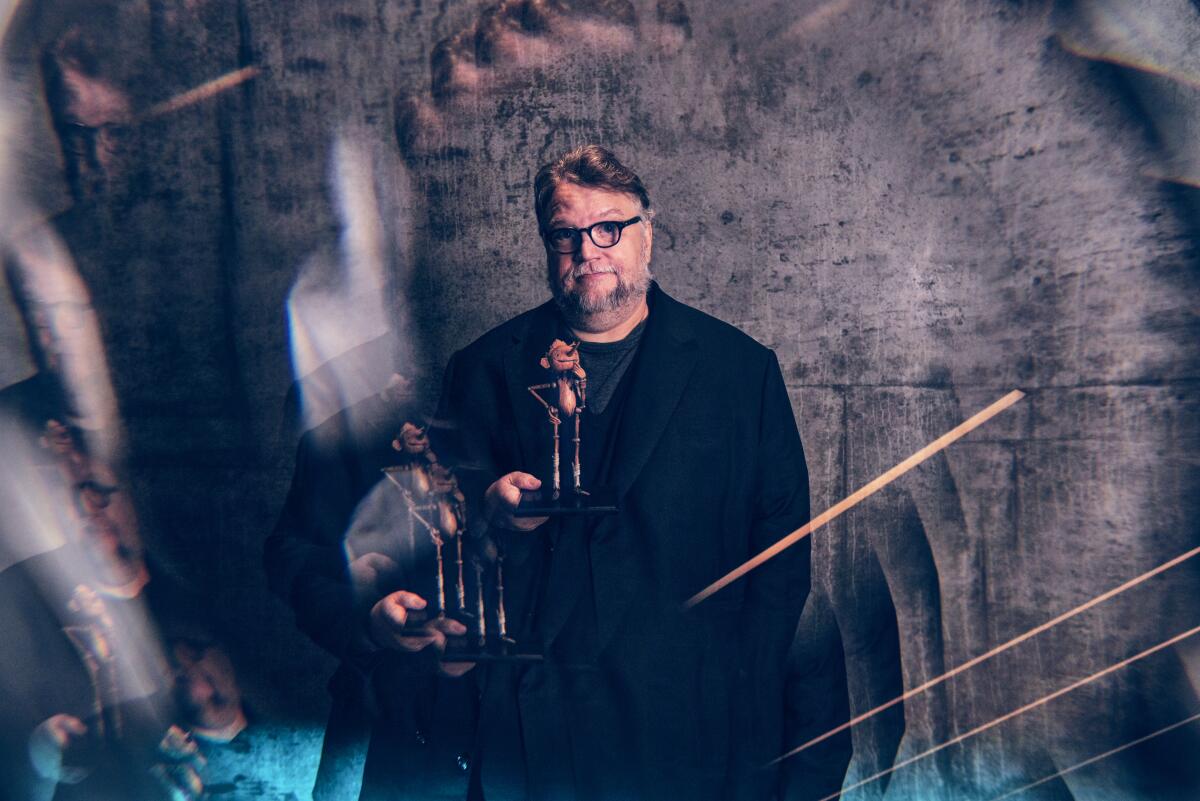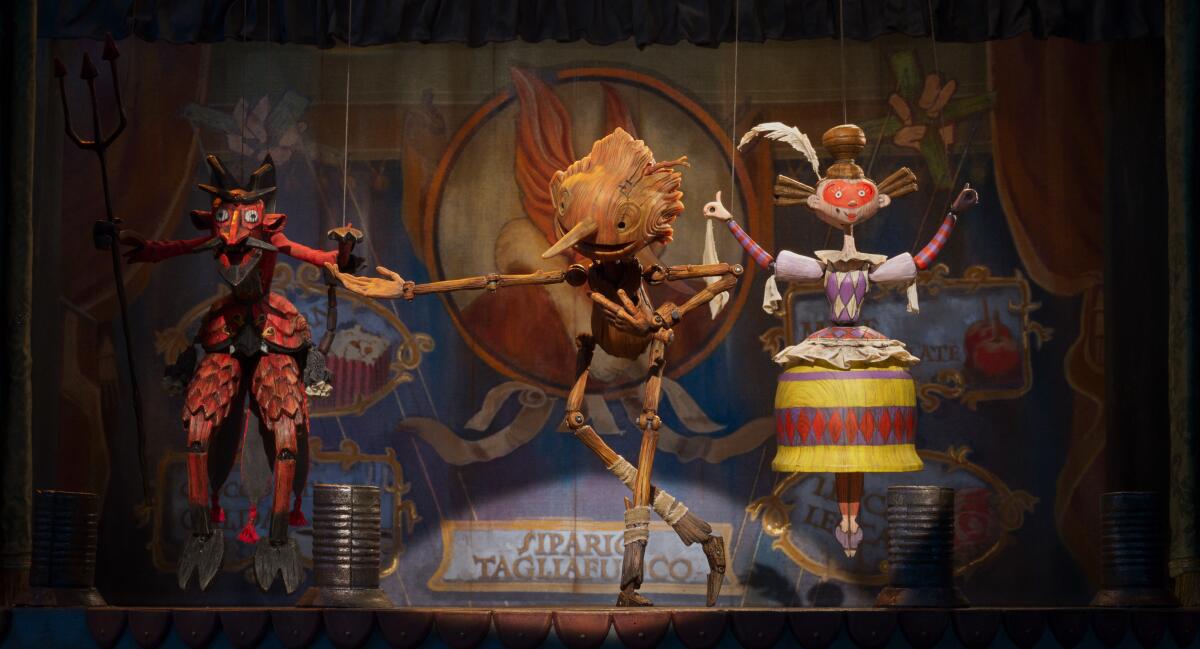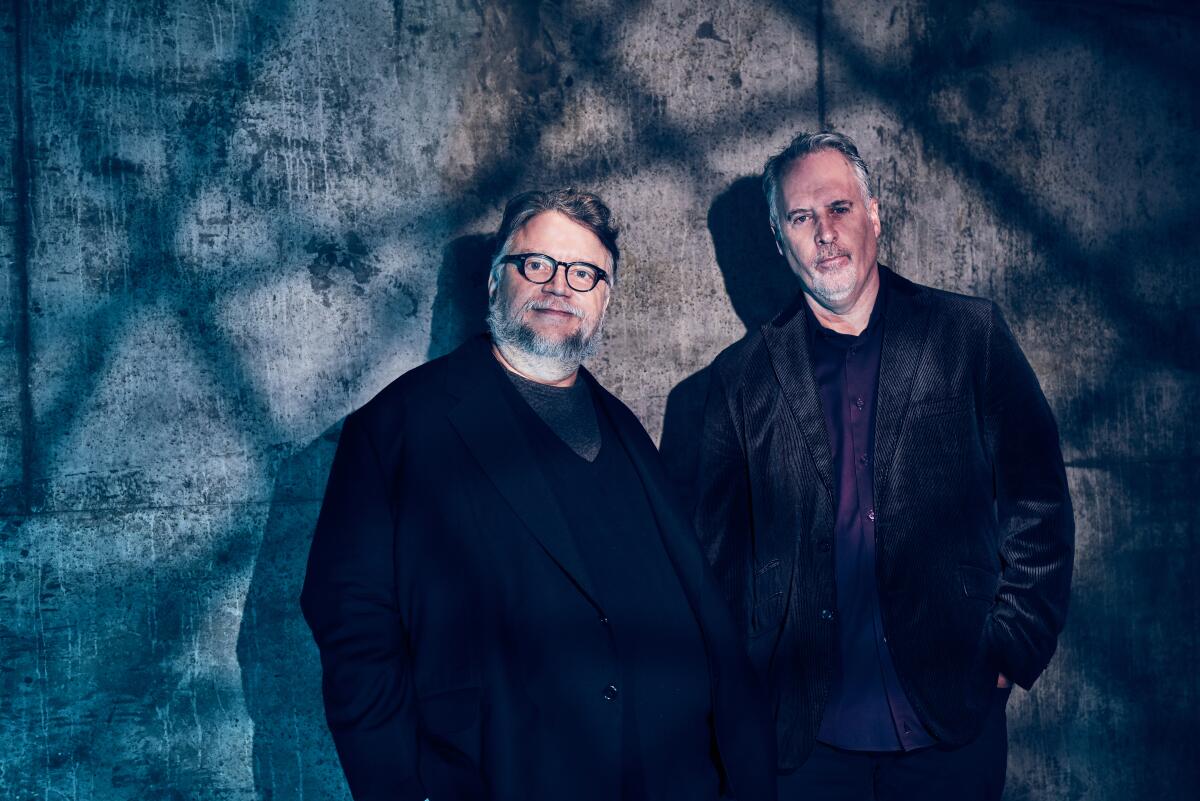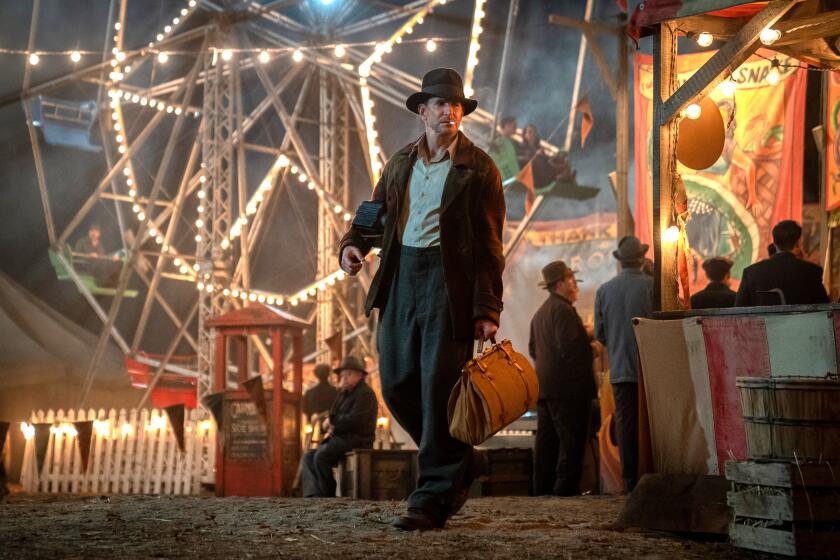In Guillermo del Toro’s darker, weirder ‘Pinocchio,’ it’s Geppetto learning the lessons

- Share via
Growing up in Guadalajara, Guillermo del Toro had two Sunday rituals — church and movies. The day began with Mass at 8, where Del Toro learned about creeds and saints and the strict rules dictating order and obedience. After breakfast, Del Toro’s parents would drop him at a small theater three blocks from home where he’d absorb a more morally ambiguous world filled with, on any given Sunday, vampires and monsters and an ape man swinging through the jungle.
“Parents wouldn’t stay, which was very auspicious for ‘Tarzan and His Mate,’” Del Toro says of the 1934 film that starred Johnny Weissmuller and Maureen O’Sullivan wearing what was then considered a revealing loincloth. “All the kids around the age of 12 were very taken with that movie. My mom used to say, ‘You really like Tarzan!’” Del Toro laughs at the memory. “Yes, Mom, I love Tarzan!”
Del Toro usually went to the movies with his older brother, but there was one that he caught with his mother, a film that bonded the two for the rest of their lives — a re-release of Walt Disney’s 1940 animated classic, “Pinocchio.” Watching the tale of a wooden puppet yearning to become a real boy, the young Del Toro lost himself in a story that contained con men and villains, wild children turning into donkeys and a desperate hero trying to rescue his father from the bowels of a whale.

“That was the fundamental movie of my childhood because it captured how scary the world looks when you’re a kid,” Del Toro says. “Primal stories like that help children decipher the world in all its complexity. The worst lie you can tell a kid is that the world is black and white. I heard that in church, but not in ‘Pinocchio.’
“For me, Pinocchio and the Frankenstein monster are two sides of the same coin,” Del Toro continues. “They’re both creations by an uncaring father released into the world without much aid to figure it out. One is an ethical fable because the monster has to construct a deeper system of spirituality. ‘Pinocchio’ is a more moral journey traditionally, in which the do’s and don’ts are related to what you need to do to be loved. It’s more a fable about domestication.”
Which, frankly, always irked the Oscar-winning director. And as he thought about “Pinocchio” over the years — and he thought about it a lot — he wondered why Pinocchio couldn’t be loved on his own terms. Forget turning into a real boy. He’s a living piece of wood with a heart as big as a forest! Shouldn’t that be enough? Forget all the talk of obedience. Defiance in the face of conformity should be the virtue that’s revered.
Given this lifelong rumination, it’s no surprise that “Guillermo del Toro’s Pinocchio,” currently playing in select theaters before landing on Netflix on Dec. 9, might be darker, weirder and, in many ways, more wonderful than the Disney movie you remember watching as a child. (Don’t confuse it with Robert Zemeckis’ live-action version, reviled by critics when it premiered on Disney+ in September.) Del Toro directed this stop-motion animated version with a veteran of the form, Mark Gustafson (animation director of Wes Anderson’s “Fantastic Mr. Fox”), and wrote it with Patrick McHale, a creative force on Cartoon Network’s beloved animated series “Adventure Time.”

The movie hews closer to the more grotesque elements found in Carlo Collodi’s 19th century folk tale, adding its own eccentric ideas about parenting, mortality and authority. Even Pinocchio’s crude and unfinished appearance, inspired by the illustrations of artist Gris Grimly, offers a startling contrast to the adorable puppet boy seen in the Disney movie.
“I said to Gris, ‘Why does he look like that?’” Del Toro says, remembering a conversation he had with the artist when he began developing the film in 2008. “And he said, ‘I think Geppetto was drunk.’ And I thought, ‘Done! That’s it!’”
In the film, Geppetto’s evening of intoxication is fueled by grief. He’s missing his beloved son, Carlo, who had been tragically killed years earlier. When Geppetto discovers the next morning that his wooden creation has improbably sprung to life, he’s understandably confused — and a little terrified. Although he does come to love Pinocchio, Geppetto can’t quite accept him, comparing Pinocchio with the romanticized memory of his late son, an attitude that Del Toro says illustrates a fundamental question about the nature of parenthood.
‘You want to coordinate all these elements to create a balance between majesty and brutality,’ the director says of his noir thriller.
“Kids are a Scrabble piece of poetry of who we are as parents,” the director says, “like you wrote a poem and then you shook it like a board of Scrabble. And the words that you want are not there in the order that you think they should be. Therefore, you do not recognize them. I learned that as a parent. And I learned that as a son. My father could not recognize the shadow he cast over me.”
Adds Gustafson: “The thing about Geppetto too is that he’s older, and you get to a certain point in your life, you just crave comfort. He wants order and into this order comes this anarchic thing creating nothing but chaos.”
Gustafson and Del Toro watched the movie for the first time with an audience when it premiered at the London Film Festival last month. Gustafson says he knew the moment people laughed at the cricket getting squished — yes, this “Pinocchio” has a cricket sidekick too — that the challenges of mixing the material’s dark themes with lighter moments had been met.
“People were crying at the end of the movie,” Gustafson says. “I like to make people cry. You can quote me.”
Del Toro was emotional too, but for different reasons. His mother, Guadalupe Gómez, the woman who introduced him to “Pinocchio,” had died the day before the premiere. Through the 14 years that he had been trying to realize his dream of making the movie, Gomez would send him carved Pinocchio figures — partly as motivation, mostly because she knew they’d bring him joy. She kept telling her son, “That’s the movie I want to see.” Del Toro was able to show her some scenes and the trailer before she died.
Reflecting on the loss, Del Toro says: “The idea I have of death is truly not fatalistic, but vitalistic. It’s easy for a Mexican to say it and make sense of it. There’s a poem by Jaime Sabines that says, ‘All of my life, I’ve heard a voice whispering softly in my ear, “Live, live, live.” It was death.’ I understand that my mother lived many, many years and died only once. And I really think this ‘Pinocchio’ represents all of our life together. I don’t want to define her by the fact that she’s gone. I like to think that this ‘Pinocchio’ symbolizes the fact that she was here. There’s something very properly stimulating about that.”
“You know,” he continues, “in Mexican culture, it’s like, ‘Is there anyone here that is not going to die? Raise your hand.’” Del Toro laughs. “No one raises their hand.”
More to Read
From the Oscars to the Emmys.
Get the Envelope newsletter for exclusive awards season coverage, behind-the-scenes stories from the Envelope podcast and columnist Glenn Whipp’s must-read analysis.
You may occasionally receive promotional content from the Los Angeles Times.









